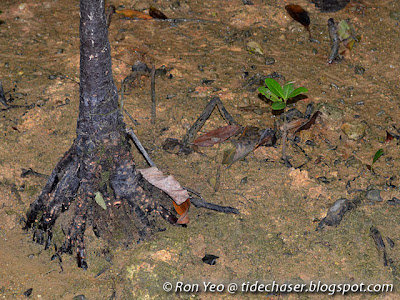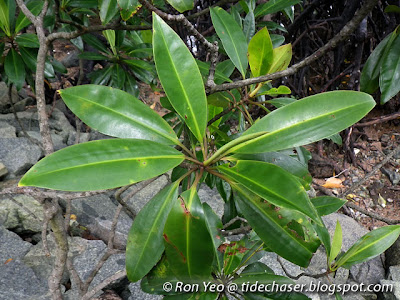The Tumu Putih (Bruguiera sexangula) is a nationally critically endangered mangrove tree from the family Rhizophoraceae.
It usually occurs at areas that are infrequently submerged, such as along tidal rivers or coastal fish ponds. In Singapore, naturally occurring ones can be found in Sungei Buloh Wetland Reserve, and on Pulau Tekong and Pulau Ubin. NParks have also planted them at Pasir Ris and Pulau Ubin.
The bark is grey or brown with a lenticels for gas exchange. Trees often have flanged stem base. The roots radiating from the tree somewhat loop above and below ground, forming knee roots. These roots help the plant breathe air, which is scarce in the waterlogged soil. The roots spread over a wide area to help stabilise the tree on the unstable ground. Like other mangrove species from the family Rhizophoraceae, B. sexangula relies on its roots to exclude salt from entering the plant through a process called ultrafiltration.
It has simple, opposite leathery leaves that are elliptic with pointed tips, clustering towards the end of the branch.
The large flowers come with white petals but rapidly turns brown.
Depending on the environmental conditions such as the amount of sunlight, the calyx varies from bright yellow to light green to even pinkish.
The blunt tips of the petals have no bristles or at most 1 or 2 short bristles.
Vivipary is observed in this plant, as with the other mangrove species from the family Rhizophoraceae. This is a condition whereby the embryo grows and break through the seed coat and the fruit wall while still attached to the parent plant. Hence, the thick and cylindrical to angular structures seen hanging/protruding from the trees are seedlings, not fruits.
The seedling is dispersed by water. It floats horizontally for a few weeks, during which the root (lower part) will absorb water and become heavier, eventually causing the seedling to tip and float vertically. As the tide goes down, the vertically-oriented seedling will sink into the mud or other suitable substrates. Most of the seedlings, however, end up being washed ashore or eaten by animals.
The wood is used for firewood, poles and making charcoal. The fruit is boiled and eaten as a vegetable. The root and leaves are used to treat burns.
References
- Chong, K. Y., H. T. W. Tan & R. T. Corlett, 2009. A Checklist of the Total Vascular Plant Flora of Singapore: Native, Naturalised and Cultivated Species. Raffles Museum of Biodiversity Research, National University of Singapore. Singapore. 273 pp.
- Giesen, W., S. Wulffraat, M. Zieren & L. Scholten. 2006. Mangrove guidebook for Southeast Asia. RAP Publication 2006/07. FAO Regional Office for Asia and the Pacific & Wetlands International. Bangkok. 769 pp.
- http://www.mangrove.my/page.php?pageid=mangrove

No comments:
Post a Comment